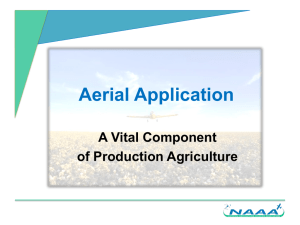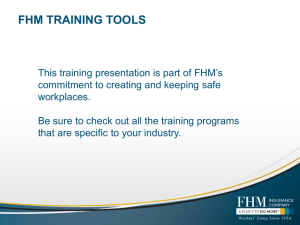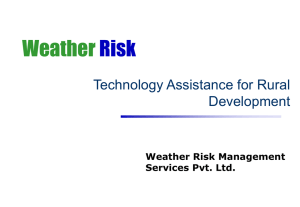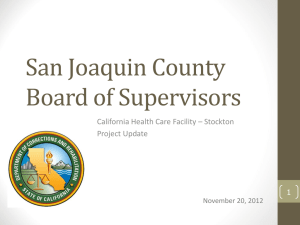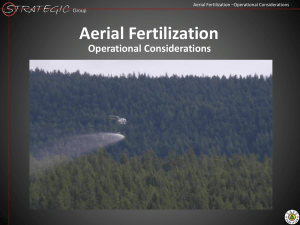Document
advertisement
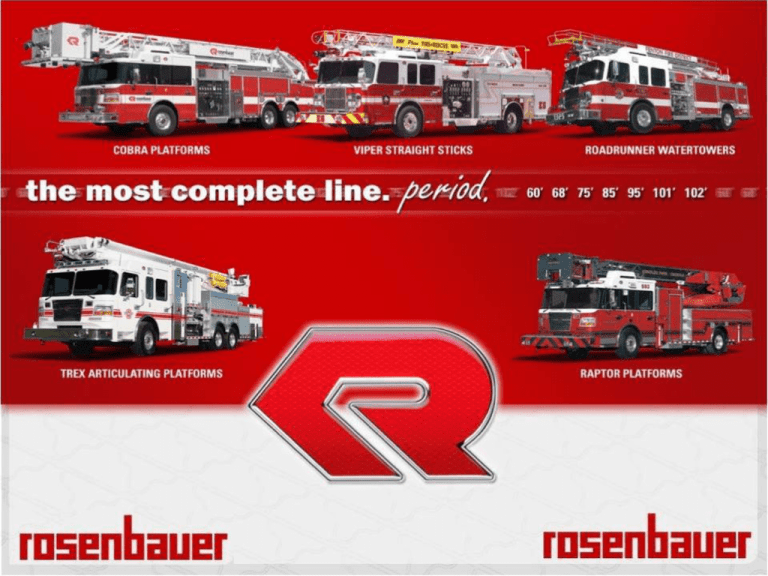
Pasco, WA Aerial Familiarization 109T123s (7312) Rosenbauer Safety Information Please read all safety information! Safety Introduction Familiarize yourself with all manuals supplied Read and follow all safety precautions Do not modify any equipment without authorization from customer service Keep ignition sources away from flammable objects Practice good housekeeping Safety Harnesses For the safety of everyone on your crew. A safety harness MUST BE WORN at ALL TIMES by any individual on the aerial! Positioning the Truck for Operation 1.Determine if the aerial will be used as a water tower or for rescue. 2.Make sure to note ALL overhead obstructions. 3.Scan scene to position the truck for best attack. NOTE: For the best positioning, a corner of a building is highly suggested. This gives the operator access to two sides of the structure as well as the roof. REMINDER: The operator should always observe the placement of the fire fighting vehicle to be sure that there is enough space for the stabilizers to be set and the aerial to be operated without any obstructions. Obstructions to be most aware of include, but are not limited to: adjacent buildings, curbs, drop-offs at road edges, man holes, vehicles, trees, over head electrical wires, ditches and culverts. SETTING FRONT OF TRUCK TO UPHILL GRADES With maximum grades the truck should be positioned with the cab facing uphill. Aerial should be operated over the rear. Advantages: 1. Can reduce the truck’s grade by extending the rear outrigger stabilizer jacks. 2. When truck is set up the front tires will be in contact with the ground. 3. With the outriggers set operator has more ballast for the operation of the aerial. SETTING FRONT OF TRUCK TO UPHILL GRADES Disadvantages: 1. Since only the front tires are on the ground there is less resistance to prevent truck movement. 2. The rear compartment and aerial access step are more difficult to access. SETTING FRONT OF TRUCK TO DOWNHILL GRADES Advantages: 1. Rear compartments are closer to the ground for easier access. 2. Better resistance to keep the truck from sliding by having more tires in contact with the ground. SETTING FRONT OF TRUCK TO DOWNHILL GRADES Disadvantages: 1. Can not reduce the trucks grade by extending the front outrigger stabilizer jacks. FRONT TIRES MUST STAY ON THE GROUND WHEN OPERATING OVER THE FRONT OF THE TRUCK. 2. It is possible that the truck will teeter if the aerial is operated over the front stabilizers with the front tires off the ground. 3. Their will be less ballast for aerial operations with the rear tires on the ground. 4. When setting up the stabilizers the ground must be firm. It is highly recommended that the operator uses the outrigger pads provided. Setting up over manholes, underground parking facilities or storm drains could cause serious damage to the operator and/or serious damage to the truck. The area must be able to support 75 PSI. Safety Around the Vehicle EXHAUST FUMES • Be conscious of exhaust fumes when working around the vehicle. • Ensure that there is adequate ventilation. • DO NOT alter emission controls. COOLING SYSTEM • Ensure there is adequate clearance between fan and shroud. • DO NOT alter fan ratio, spacers or position. • Observe fan clutch operation to ensure fan is disengaging when cooling is not necessary. AIR INTAKE SYSTEM • DO NOT alter any intake piping or filter locations. Safety Around the Vehicle UNDERCARRIAGE • • • • Notify others when working underneath the vehicle. Keep away from moving parts. Avoid hot areas such as engine, transmission, exhaust and pumps. Avoid ports that may eject steam or other hot fluids. COVERS AND DOORS • DO NOT sit, stand, climb or hang on open doors. • Some doors are spring loaded. Use caution when opening doors. • Use care not to get fingers and hands caught in pinch points such as hinges. • Do not drive with doors partially closed. TIRES AND WHEELS • Deflate tires prior to removal. • DO NOT operate vehicle with damaged or improperly inflated tires. PRECAUTIONS FOR DRIVING SAFETY AND AERIAL OPERATION Vehicle Safety ENTERING, EXITING AND CLIMBING • Keep steps, handles, rails, walking surfaces and shoes free from grease. • Use extreme caution during inclement weather or when surfaces are wet. • DO NOT use pump fixtures or lights as stepping surfaces. • DO NOT stand near hose when vehicle is moving. • Make deliberate movements when entering, exiting or climbing on the vehicle. DO NOT rush. • DO NOT climb in areas without slip resistant surfaces and hand holds. • Use a three point stance in which three extremities are in contact with the vehicle, when entering, exiting or climbing on the vehicle. Vehicle Operational Safety VEHICLE BACKING • Use a spotter when backing vehicle. • Establish hand or verbal communication prior to backing. • During periods of low light use spotter with wands and reflective vests. VEHICLE CONTROL • Ensure proper tire inflation before operating vehicle. • A neutral safety switch prevents vehicle from being started in gear. • Allow starter to cool for one minute if vehicle doesn’t start within 15 seconds. • Familiarize yourself with gauges, switches and on-board accessories prior to operating vehicle. WATCH YOUR TURNING Increased overhangs, particularly at the rear, must be kept in mind. NOTE: In narrow crossings the driver must confirm that there is enough space for turning. KNOW YOUR TRAVEL HEIGHT NOTE: The driver must confirm the vehicle can freely pass low underpasses. KNOW YOUR TOTAL WEIGHT NOTE: The driver must confirm the vehicle can freely pass limited weight areas. WATCH YOUR ANGLE OF DEPARTURE GROUND CLEARANCE AND THE ANGLES TO FRONT AND REAR STRUCTURES. REMEMBER HIGH CENTER OF GRAVITY HEIGHT OF THE CENTER OF GRAVITY. NOTE: Speeding with the vehicle when turning a corner is DANGEROUS! REMEMBER 60% OF YOUR WEIGHT IS ABOVE YOU Rosenbauer 109’ Viper Aerial Rosenbauer Commander Flat Roof Cummins ISX 500 hpEngine Waterous CSU 2,000 gpm pump 400 gallon water tank Green Star genset system CAB TILT PROCEDURES Before tilting cab check the following: Front bumper storage lid is closed. No equipment on front bumper. Inside cab -all loose equipment removed such as air packs, books, portable radios, helmets, etc YOU MUST SET THE JACKS AND RAISE THE AERIAL BEFORE TILTING CAB! • Raise the Aerial to 20 degrees • Shut the engine down • Leave battery switch on • Go to right side pump panel compartment • Operate switch to raise cab CHECK SAFETY BAR LOWERING CAB Check to see if area is clear to lower cab! Raise cab fully Pull cable until cab safety lock is away from the cab cylinder and hold Hold switch down Cab will automatically lock down Pump and Plumbing info Waterous 2000 GPM pump Stainless Steel plumbing Discharges Crosslays 2-1/2” Discharges LDH Discharges 25 ANTI-ELECTROCUTION PLATFORM The pump control panel operator should stand on anti-electrocution platform when the aerial is being operated. Standing on the antielectrocution platform will raise the pump operator off the ground and keep the operator from being a pathway to ground for electrical current if the aerial contacts and energized line. Pump Engagement Neutral Switch from Road to Pump Shift to 4th gear 29 Drains 30 GENERATOR ELECTRICAL PANEL • Generator has a monitoring system that lets you see amps, line voltage, and frequencies. • Breaker panel box is equipped with GFI breakers. 34 Aerial Technical Info Aerial Vocabulary Aerial Types: Mid-Mounted Aerial Ladder Rear-Mounted Aerial Ladder Mid-Mounted Aerial Platform Rear-Mounted Aerial Platform Aerial Vocabulary Base-Section – the lowest most section on an aerial Mid-Section – is any of the sections used between the base section and the fly section Fly-Section – the top most section on an aerial Short-Jack Operation – allowing aerial to operate in predefined zones with outriggers/stabilizers not fully extend Aerial Vocabulary Torque Box (tube) – part of an aerial attached below the turntable to transfer torsion loads to the chassis and outriggers. Turntable – part of the aerial device attached to the base ladder section designed to articulate the position for rescue or firefighting E-Tracking - a flexible track utilized to protect electrical, communication and control wires in aerial extension/retraction Soft-Touch Control - electric control of aerial functions through the use of a remote manual control programmed to slowly start and stop aerial functions Auto-Bedding Control – automatic aerial bedding when aerial is in predefined zone Dead Load – weight of aerial and attached mechanism and equipment Live Load (Tip Load) – weight and forces exerted on the aerial by payload, and water stream reactions. Outrigger/stabilizer – a hydraulic lifting mechanism designed to prevent aerial overturn and transfer loads to the ground Aerial Vocabulary Rated Capacity – total weight of payload at the outermost ladder rung or platform according to ladder load chart Cab-Body Collision Protection – program preventing aerial device from collision with chassis and equipment mounted on the body Pinable Waterway – manual device designed to place the waterway at the tip or next lower section Modified Warren Bridge – design of aerial structure to transfer loads up and down the aerial device. Bolt-On Egress – outermost extension device designed for personnel to climb on/off the end of the aerial Yield Strength – point at which the material exhibits a permanent deformation or set Water Load – stress produced by water weight and nozzle reaction overhead to the side and below stream applications Hot Dipped Galvanized – a process for treating steel ladder and stabilizers to prevent corrosion and oxidation on the inside and outside of all the ladder parts Aerial Vocabulary Dead load Stress – stress produced by the aerial structure weight and any permanently mounted or manufactured equipment Rated Capacity Stress – stress produced by the aerial rated capacity applied to the tip of the fly section Water Reaction Stress - weight of the water and nozzle reaction force Material Yield Stress – the stress at which a material exhibits a distortion or permanent set Load Limit Indicators (Load Charts) - a load indicator or instruction plate, visible at the operators position, showing the recommended safe load at any condition of the aerial’s elevation and extension 109’ 4-Section Rear Mount Aerial 4 Outriggers with a spread of 15’ 6” Tip load wet of 500 lbs. Dry 500 lbs Water flowing at 1000 GPM 90° to the side Horizontal reach at 0° is 102’ Elevation of -10° to 75° vertical height Axel ratings 23,000 front & 54,000 tandem rear Wheel base 244” Standard Height – 12’ – 0” Standard Length – 41’ – 4” Load Chart Setting Up Your Cab for Aerial Operation 1. Shift transmission (1) from drive into neutral. 2. Apply the parking brake (2). 3. Switch on the aerial master (3). When the aerial master is switched on there is electrical power to the aerial system. At this time flashing lights on the outriggers will begin to operate. 4 1 2 4. Switch on the Power Take-Off (PTO). Note: It is important to note that step # 4 cannot be performed before step # 3 has been completed and step # 2 cannot be completed until step # 1 has been completed. Some trucks will have the aerial master and PTO switch combined . The transmission must be in neutral (4) or 4th gear for the water pump to be engaged. The parking brake must be set before the ladder power will operate. If the water pump is engaged, the high idle of the aerial will be disengaged. 3 Outrigger Operation Set Up Once the ladder power is activated, the flashing light (1) on the inside of the outrigger jack tubes will begin to flash and the outrigger jack scene lights (2) will come on. 1 1 Outriggers are ready to operate. 2 Outrigger Operation Set Up With tire chocks set the operator will proceed to the outrigger station. The Outrigger Not Extended Light will be illuminated. This light will stay illuminated until all outriggers have been fully extended and are making contact with the ground. 1. Move Outrigger On/Off Switch to the ON position This will cause the high idle to engage and the warning alarm will begin. The alarm alerts all other personnel the outriggers are being positioned. If the water pump is engaged the high idle of the aerial will be disengaged. 1 Outrigger Operation Set Up 2.Use Controllers to Extend Outriggers. The outrigger controls are located to the back, outside of the truck to provide the operator a good clear vision to set up the outriggers. The controllers are designed to move in the same direction as the corresponding outrigger. (Example: To extend the right outrigger you would push the controller to the right to extend and to the left to retract.) 3.Position outrigger pads under jack locations Outrigger Operation Set Up 4.Lower outrigger jacks The controllers are designed to move in the same direction as the corresponding outrigger. (Example: To lower the right outrigger you would push down on the controller.) Take the bubble out of the truck tire or level truck as much as possible. As the truck is leveled or the bubble is taken out, each Jack Indicator Light (3) will respond 3 according to how the outrigger is set (see different setting under Jack Indicator Light description on the control panel). 3 Once all outrigger beams are fully extended and making contact with the ground the Outrigger Not Extended Light will go out. 3 3 Outrigger Operation Set Up 5.When outriggers are set move the Outrigger On/Off Switch to the OFF position. 6.Install outrigger jack safety pins. Safety pins are not required for operating the aerial. However, we strongly recommend installing them as an additional back up safety feature. 7.Outrigger operation set up is completed. Should any two outriggers at any point come off the ground the aerial will come to a feather-soft stop. The operator will need to retract and raise the aerial out of the unsafe position. Once the aerial is in a safe position the aerial can continue operations as normal. 1 Outrigger Control Panel Diagram 1. Outrigger On/Off Switch 5 2. Aerial/Outrigger Override Switch 3. Jack Lights 4. Outrigger Not Extended Light 5. 4 3 3 3 3 Hour Meter 6.Emergency Hydraulic Backup Pump Switch 7.Change Hydraulic Filter when Light is On 2 6 7 1 Outrigger On/Off Switch 1. Outrigger On/Off Switch The Outrigger On/Off Switch must be turned on before the outriggers can be operated. This will enable the high idle if water pump is not engaged. 1 Aerial/Outrigger Override Switch 2.Aerial/Outrigger Override Switch With the aerial out of the bed, the outriggers can no longer be operated. If a case arises where the outriggers need to be readjusted, activate the momentary Aerial/Outrigger Override Switch down to Outrigger Override. Adjust the outrigger controls (left/right, up/down) until the outrigger is set to the desired place. If a case arises where the aerial needs to be overridden, activate the momentary Aerial/Outrigger Override Switch up to Aerial Override. A second operator will then need to adjust the aerial to the desired location using the manual aerial controls (extend/retract, left/right, raise/lower). Extreme caution must be taken when using the overrides. 2 Jack Lights 3.Outrigger Jack Lights The Jack Lights are provided for each outrigger jack to indicate when an outrigger makes contact with the ground. Each individual outrigger status Jack Light has four conditions to provide, at a glance, the position of each outrigger’s condition. – The Jack Light will remain unlit when the outrigger is fully retracted and the jack is not set on the ground. – The Jack Light will flash rapidly (five flashes per second) if the outrigger is extended and the jack is not set on the ground. – The Jack Light will flash slowly (twice per second) if the jack is set on the ground but the outrigger is not fully extended. – The Jack Light will remain lit solidly if the jack is set on the ground and the outrigger is fully extended. 3 3 3 3 Outrigger Not Extended Light 4. Outrigger Not Extended Light – The Outrigger Not Extended Light will be lit solidly if any outrigger is not fully extended – The Outrigger Not Extended Light will be lit solidly if any jack is not set on the ground. – The Outrigger Not Extended Light will flash rapidly (5 times per second) if the aerial is out of the bed and the outrigger switch is turned on preventing outrigger operations. 4 Hour Meter/Emergency Hydraulic Backup Pump 5. Hour Meter The Hour Meter keeps record of the hours the aerial has operated (only while the aerial is moving). 6. Emergency Back-Up Pump On/Off Switch The sole purpose of the Emergency Back-Up Pump is to stow the aerial in case of hydraulic failure. To Use Emergency Back-Up Pump 1. Select the operation required (outrigger or aerial) and move switch to the on position. 2. Engage the outrigger or aerial control handle. 3. Activate momentarily the Emergency 12V Back-Up Pump 4. To ensure that the Emergency Back-Up Pump doesn’t over heat, it can only operate 5 minutes out of 60. 6 Change Hydraulic Filter when Light is On 7.Change Hydraulic Filter When Light is On When this light is illuminated the high pressure and return hydraulic filters are dirty and need to be changed, both filters are connected to the same light. 7 Short Jacking A red warning light (outrigger not extended light) at the outrigger and aerial operator’s control consoles will warn the operator that one or more outriggers have been short jacked. The jack lights on the outrigger panel will indicate to the operator which outrigger is short jacked. Using the Programmable Logic Controller (PLC), it is possible to safely operate over short jacked outriggers. The PLC takes continual readings of the load, extension, elevation and rotation of the aerial. The PLC allows the aerial to rotate over the short jacked outrigger. If the aerial is moved over an area with a short jacked outrigger the permitted extension and elevation is controlled by the distance the short jacked outrigger is extended. Short Jacking The operator can rotate the aerial over the short jacked outrigger as long as it is within the safe operating parameters. If the aerial is not within the preset parameters, the PLC system will automatically ramp the aerial to a feathersoft stop. The only way to rotate out of this position is to retract or raise the aerial and rotate it to the side of the truck where the outriggers are fully deployed. If the aerial is lowered or extended to far when rotated into a short jacked area the rotation will come to a smooth feather-soft stop. Retracting or raising the aerial will return it to a safe operating condition. With one or both front outriggers extended less then 25 percent the aerial will not elevate above 45 degrees. Aerial Command Seat Control Panel Smart Aerial Command Seat Control Panel 1 1. Emergency Stop Switch 2. Aerial Load Monitor 2 3. Rung Alignment Light 4. Outrigger Not Extended Light 5. Auto Bedding Switch 6. Operational Envelope Lights 3 4 5 6 Aerial Command Seat Control Panel Smart Aerial Command Seat Control Panel 1. Monitor Controls 1 2. Flowmeter 3. Flowmeter Totalizer 4. Monitor Stow 2 4 3 Emergency Stop & Breathing Air 1. Should the operator come into a dangerous situation and need to stop the aerial immediately push down on the emergency stop button and the aerial will come to an immediate stop. The operator will need to pull up on the emergency stop button in order to reactive the aerial operation controls. Aerial Load Monitor 3. An aerial load monitor will continuously monitor the load on the device. It includes three lights green amber and red. The green light indicates the load is within load limits. The amber light indicates caution, alerting the operator that the load is getting closer to overload. The red light will flash when the rated load capacity is approximately 50 pounds less than the rated live load. The horn will emit a constant sound when the rated capacity is exceeded by more then 100 pounds of the rated live load. Rung Alignment Light & Outrigger Not Extended Light 3. The rung alignment light will illuminate when the rungs are aligned. While extending or retracting the aerial this light will flash on and off in accordance with the rungs being aligned. It is recommended that the rungs be aligned when personnel are climbing the aerial for personal safety. 4. The outrigger not extended light will be illuminated if any outrigger is short set or doesn’t have solid contact with the ground. Auto Bedding Switch 5. The auto bedding switch is a momentary switch. The aerial needs to be less the 20% extended, within 20 degrees to the right or left of the ladder bed and below 20 degrees elevated. Activate on the momentary auto bedding switch and the aerial will automatically bed itself. If the switch is released the aerial will stop moving. Operational Envelop Lights 6. Three amber lights (left disabled, down disabled & right disabled) indicate which functions of the aerial have been disabled. Should the aerial enter an overload situation the down disable and right and/or left disable light will illuminate indicating the aerial will need to be retracted and raised in order to continue operations. If the aerial is lowered at a preprogrammed position over the cab or body the aerial will come to a smooth stop and the down disabled light will illuminate. If right or left rotation light is on the aerial is restricted from operating in that direction. With the ladder in the bedded position both left and right disabled light will be on and the down disabled light will be off. Monitor Control Switches 1. Three monitor toggle switches or the manufactured monitor controls will control the monitor (stream/shape, right/left, lower/raise). Push up on the individual switches to activate the stream, right & lower functions of the monitors. Push down on the individual switches to activate the shape, left and lower functions of the monitors. To turn off the switches the operator will need to release the switch to the neutral position. Flow Gauge/Totalizer 2. Flow Gauge The flow gauge will give a continues reading of the water flowing from the monitor. Depending on options this could be a combination pressure and flow gauge and will vary by manufacturer. 3. Flow Gauge Totalizer The totalizer button only comes with certain flow gauges. Press the button to get the total amount of water flown. Monitor Stow 4.Monitor Stow Push switch to the on position to stow the monitor. Aerial Joystick Controls 1. 1a. 2. 2a. 3. 3a. 4. 4a. 5. 6. 7. Wireless Radio Remote (optional) Wireless Radio Remote Indicator Light Tip Light Button Tip Light Indicator Light Tracking Light Button Tracking Light Indicator Light High/Low Button High/Low Indicator Light Thumb Control Extend/Retract Aerial Raise/Lower, & Left/Right Trigger Switch Wireless Radio Remote Control & Indicator Light 1. Wireless Radio Remote (optional) This button will only be an active button if you have opted to have a wireless radio remote. Push the button in to activate the wireless radio remote. 1a. Light Wireless Radio Remote Indicator When the wireless radio remote is active this light will be illuminated. Tip Lights & Indicator Light 2. Tip Light Button The tip light button controls all the AC and DC lights on the tip or front of the aerial. Push the button and the lights will turn on. The switches on the individual light heads will have to be in the on position for the light to turn on. 2a. Tip Light Indicator Light When the tip lights are activated the indicator light will illuminate. Tracking Lights & Indicator Light 3. Tracking Light Button The tracking light button controls all the AC and DC lights at the base of the aerial. Push the button and the lights will turn on. The switches on the individual lights heads will have to be in the on position for the light to turn on. 3a. Tracking Light Indicator Light When the tracking lights are activated the indicator light will illuminate. High/Low Button & Indicator Light 4. High/Low Button To run the aerial this button needs to be placed in the high or low position. To run the aerial at normal speed push the button on to the high position. For a new or inexperienced operator we recommend running the aerial at low speed (half the normal speed). 4a. High/Low Indicator Light When the high/low indicator light is illuminated the aerial is running at high speed. If the light is off then the aerial is running at low speed. Thumb Control Extend/Retract & Aerial Raise/Lower & Left Right Controls 5. Thumb Control Extend/Retract The thumb control controls the extension and retraction of the aerial. Push the thumb control forward and the aerial will extend. Pull the thumb control back and the aerial will retract. Functions will not work without first engaging the trigger switch. 6. Aerial Raise/Lower & Left/Right The aerial joystick moves forward to back and left to right. If the operator moves the joystick left to right the aerial will move in the corresponding direction. Pushing forward on the joystick will cause the aerial to lower. Pulling back on the joystick will cause the aerial to raise. Functions will not work without first engaging the trigger switch. Trigger (Dead Man) Switch 7. Trigger (Dead man) Switch The trigger (dead man) switch works in the same fashion as a dead man foot switch on a manual aerial. Pull the trigger and it allows the thumb control and the aerial joystick to become active. Once the thumb control or aerial joystick is moved the dead man switch is activated and the RPM will rise to a preset condition, if the water pump is not engaged. Aerial Control Panel Diagram Aerial Intercom Push the talk switch to communicate to the other intercom. The volume knob adjust the sound. Aerial Control Panel Diagram Warning Labels The warning labels are located in the lid and will warn the operator of potential life threatening situations that could occur when operating the aerial. Water Flow • 3 ways to use your aerial to flow water – From main pump through Aerial Devise – From external source to Aerial Devise – From main pump and use waterway inlet as a large diameter discharge. Water flow from pump • To discharge water from the main fire pump through the aerial devise: – Open the Aerial Discharge valve at the pump panel – Open the Aerial butterfly valve at the turn table. Water Flow from relay • To discharge water from relay operations through the aerial devise: – Close the Aerial Discharge valve at the pump panel – Open the Aerial butterfly valve at the turn table. – Connect incoming water source to Waterway Inlet at rear. Water Flow Aerial LDH • To discharge water from rear aerial waterway / discharge connection: – Open the Aerial Discharge valve at the pump panel – Close the Aerial butterfly valve at the turn table. – Connect discharge hose to Waterway / Inlet at rear. Summary and Hands On Q& A??????? Practical operations of aerial to include: 1.Positioning of the truck 2.Outrigger operation, placement and setup 3.Operation of the aerial from the turn table 4.Operation of the aerial from the remote control 5.Moving water


